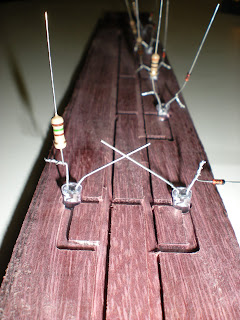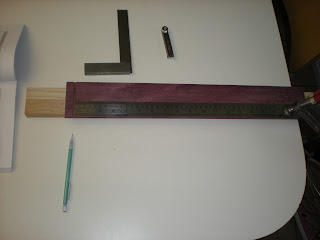Experimental LED Guitar Body
This is my LED guitar body. It's made of poplar. It's sort of a strange concept; I wanted to make a Stratocaster type guitar, but I wanted to have the Telecaster type control plate. I started playing around with aluminum, and discovered I could make any shape aluminum plate using a bandsaw, and then sand the edges smooth and use a router to do a 45 degree bevel. The result: a nice looking aluminum control plate, or battery cover, but definitely NOT CHROME. (I'll discuss this more later...)
I ended up tilting the control plate diagonal instead of vertical like a real Telecaster. Also, for simplicity's sake I wanted only one pickup. Not quite a bridge pickup, and not quite a neck pickup. Right in the middle. For simplicity's sake I also didn't really want a tone control knob. I always leave my guitar tone at full brightness anyways. Who wants to bleed all their highs to ground?
To sum it up: one pickup, one output jack, no tone knob, and the volume knob is a maybe... I haven't decided yet. As of now (January 2012) I decided that I definitely will put in a DIY guitar preamp, powered with the same 9V battery as the LED's. Oh, and possibly a killswitch...
Like I said, this is a very weird guitar concept. The next guitar I make will have all the same bells and whistles most electric guitars have, plus a few added perks: Floyd Rose tremolo, preamp, and LED's.
At first I had this idea to do a black dye stain on the body, so that when I used some clear finish you could still see the wood grain. But it didn't show the grain well enough, so I decided to spray it with grey primer and then sparkly blue bicycle paint.
Here it is before I decided to modify it some more.
Here is the aluminum control plate, in sharp contrast with the chrome pickup.
Perhaps some buffing will help.
Here is the back before I modified it, and routed out a battery cavity.
And here you can see that I cut away some of the bulky wood.
It makes it slightly more comfortable for my fret hand to reach the high frets.
I used an angle grinder with a ROUGH grit sanding disk.
And here is the guitar with a new hole for the ON/OFF/ON switch.
I attached a handle so I could hold it away from my body while spraying.
The handle also allowed me to hang it up in the garage.
And here you can see the battery cavity. It's an odd sort of shape.
I plan to make an aluminum plate to cover the battery cavity too.
So after I sprayed it with the blue spray paint, it looked pretty good. Then I tried to spray polyurethane finish on it. I'm not sure what happened, but the polyurethane didn't adhere (stick) to the paint very well. I noticed some cracks and bubbles, and when I pushed on them the polyurethane started to peel off.
I got so mad I didn't touch this guitar for almost a year. Eventually I pulled it out, and started beating on it to make it look "vintage." I sanded through some of the paint too, and scuffed it up where the pick might hit. I dragged it on the ground a little, and banged the corners on cement. After all that I applied a coat of good ol' lacquer. Now it looks very strange indeed. It doesn't quite look like an old guitar, but doesn't look new either. Oh well. It has character.















































